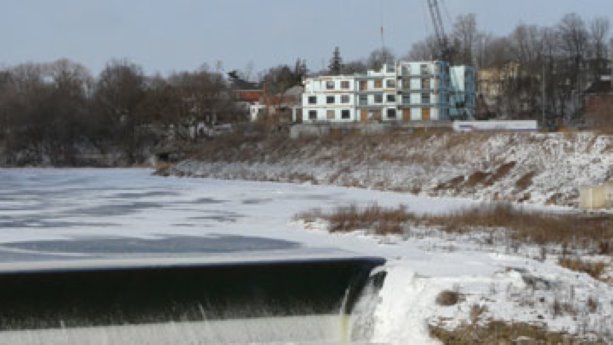It’s one of the prettiest sites in Cambridge. The large, empty lot sits beside the Grand River where it tumbles over a waterfall just before flowing into downtown Galt.
Environmental engineering
CAMBRIDGE, Ont.
It’s one of the prettiest sites in Cambridge. The large, empty lot sits beside the Grand River where it tumbles over a waterfall just before flowing into downtown Galt.
Developers have fancied the property for years, but the suitors soon packed their bags and left town after learning about its heritage.
There’s a reason that riverside lot sat abandoned for half a century. It was the original home of Galt Gas Works, a smelter that extracted coal oil from coal and eventually left carcinogens and other toxins in the ground.
Cambridge mayor Doug Craig says the two-acre lot on the river is one of the most attractive sites in Cambridge, but also one of the most contaminated.
Developer Paul de Haas doesn’t fear brownfield sites. He has converted industrial brownfield sites in the city cores of Kitchener, Waterloo, Guelph and Toronto into attractive residential projects. And he’s in the midst of doing just that to Cambridge’s Galt Gas Works site on the Grand.
A new provincial act has helped de Haas and other developers tackle such challenges. The TIF (tax increment financing) program allows municipalities to use tax dollars to encourage developers to rehabilitate contaminated sites in municipal core areas.
Future property tax revenue from a cleaned-up site rehabilitated for residential or commercial use goes to the developer for a specified period or amount to offset the additional costs of the clean up.
It took de Haas, president of Haastown Development Group, more than four years to get a building permit for his riverside project, but today the Waterscape condominium is rising on the site.
De Haas says he could never have considered building on the Grand’s east bank without the TIF program, but he adds “we really need a better attitude of co-operation between private business and the various levels of government if we are going to convert abandoned brownfields in the urban core to residential use,” said de Haas.
“There are some wonderful sites that can be put to good use in the cities, but it is much easier for a developer to put housing out on green agricultural lands than it is to clean up old industrial sites,” said de Haas.
He said municipal politicians usually understand the financial restrictions on resurrecting contaminated sites, but says too often bureaucratic red tape and officious bureaucrats hamper or thwart the wishes of the elected officials.
To get his Waterscape project underway in Cambridge de Haas gives credits Mayor Craig and Ben Tucci, the city councilor for that area.
“They were instrumental in getting the other major approval bodies in sync with one another — namely The Region of Waterloo, The Ministry of Environment, The Grand River Conservation Authority. Their efforts were extremely strong during the credit crisis in the fall of 2008 when the project financing was set to expire if all permits were not in place by Oct. 31.”
The 12-storey condominium will be one of the tallest buildings in the province built with insulating concrete forms (ICF). Extruded polystyrene blocks are snapped together like giant Lego blocks and concrete is poured into the form, along with reinforcing steel. The form stays on the finished wall, adding two to three inches of insulating foam on both sides.
The concrete floor panels are precast off site and lifted into place by a large mobile crane on the site, said Greg Pannia, general manager at Aurora’s Elite Building Group, which specializes in ICF construction.
Pannia said the ICF method significantly reduces construction debris at the site, cuts the need for disposable wood framing and reduces energy required for heating and cooling the structure.
Because of its location beside the Grand River de Haas hired EBS Engineering and Construction of Breslau, Ont. to drill 720 helical pilings 40 feet down to bedrock to stabilize the footings and foundation.
There will be 115 suites in the building with prices starting at $159,900 for a one bedroom residence with 528 sq. ft. and ranging up to 1,405 sq. ft. for $484,900.
Ciancone and de Haas plan to work together to clean up the contaminated south end of the Waterscape site. De Haas proposes a second phase of Waterscape on the south end of the property, adjacent to Ciancone’s restaurant.
Mayor Craig said the Waterscape project at the entrance to downtown Galt has triggered interest in rehabilitating other brownfield sites in the city core.
Drayton Theatres proposes to build a 600-seat live theatre a couple blocks south of Waterscape. The new centre will also serve as the corporate headquarters for the five other theatres Drayton operates in southwestern Ontario.











Recent Comments
comments for this post are closed